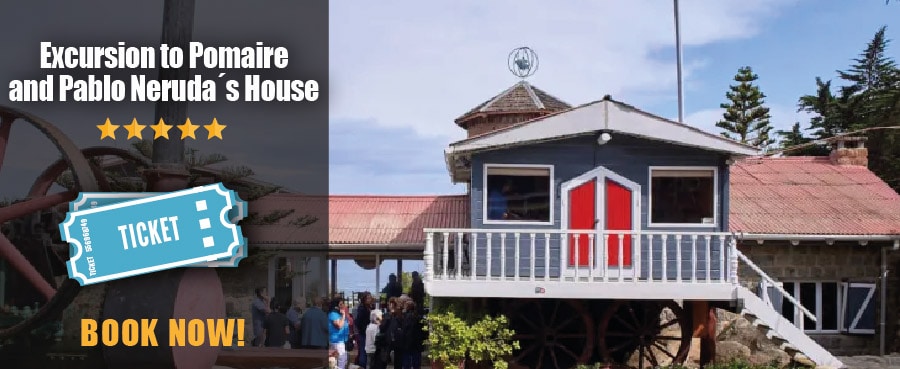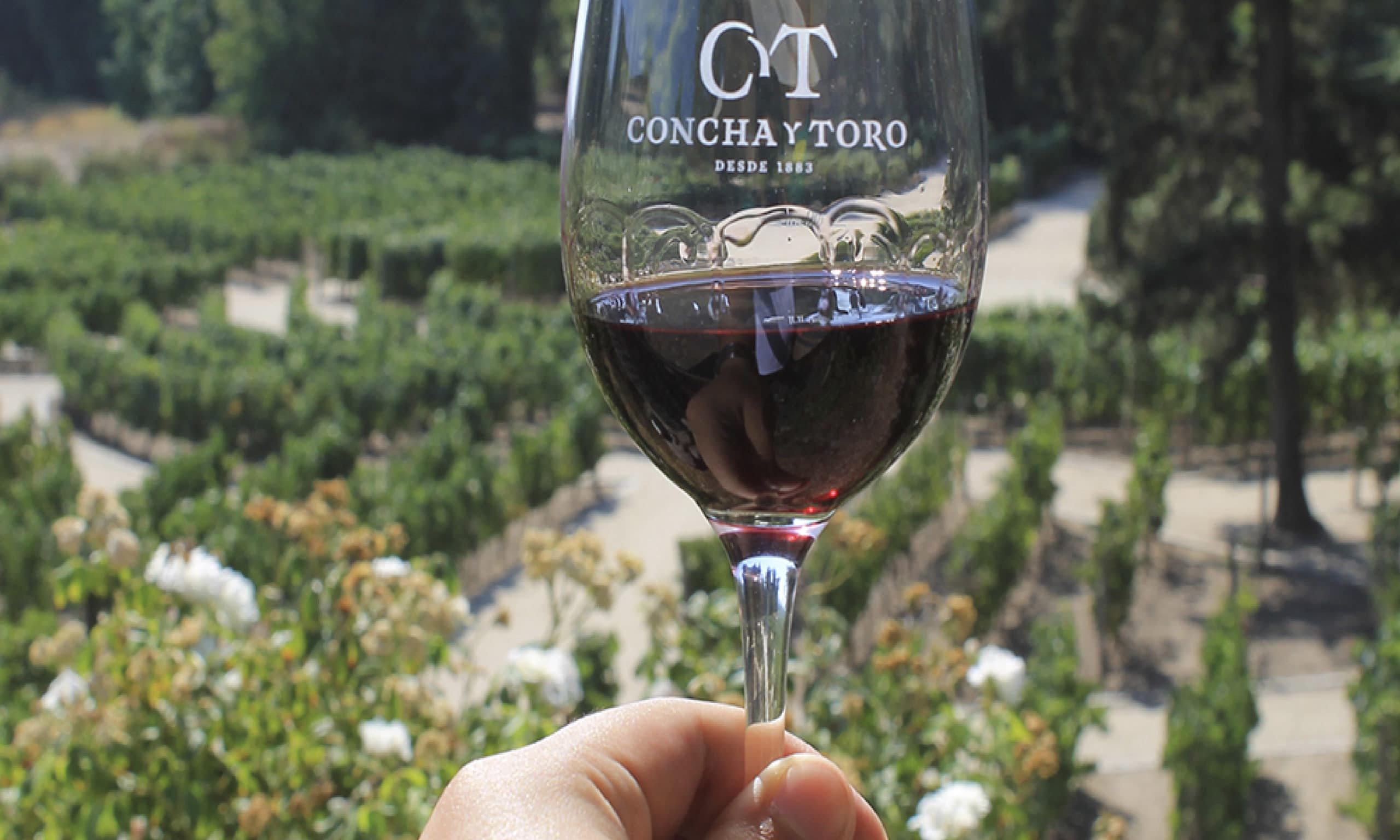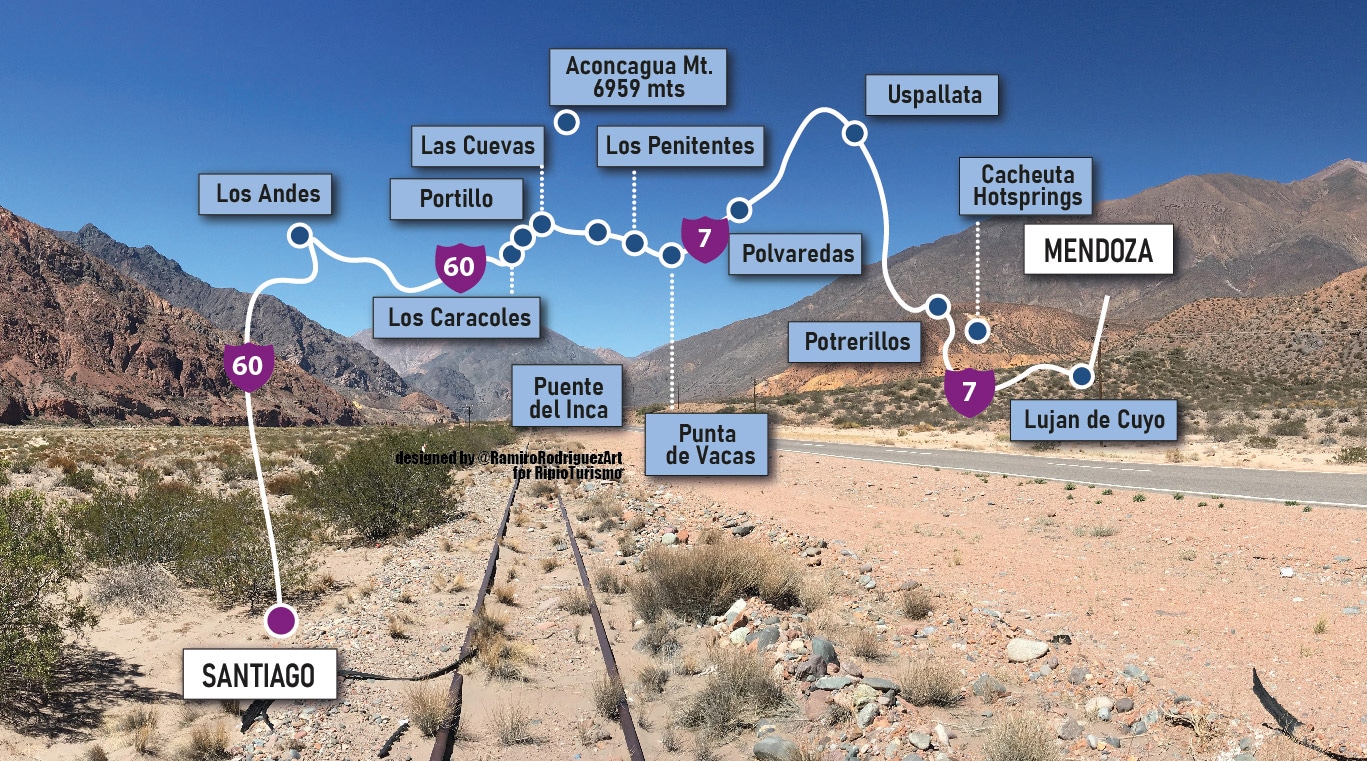Pablo Neruda: learn more about the chilean poet
One of the attractions for many visitors who come to Santiago is to learn more about Pablo Neruda. But who was Pablo Neruda?
Who was Pablo Neruda?
Pablo Neruda, also known as Ricardo Eliécer Neftalí Reyes Basoalto is a famous Chilean poet born in Parral on July 12, 1904 and died in Santiago, Chile, on September 23, 1973. Besides being a poet, Neruda was a renowned Chilean politician.
He is considered among the most prominent and influential artists of his 20th century; in addition to having been a senator of the Chilean Republic, a member of the Central Committee of the Communist Party, a candidate for the presidency of his country and ambassador to France. Among his many recognitions, the Nobel Prize for Literature in 1971 and an honorary doctorate from the University of Oxford stand out.
Neruda’s literature distinguishes different stylistic periods. Since his work Canto general (1950), the author is circumscribed in the so-called Soviet socialist realism, promoted by Andréi Zhdánov, and in which Neruda would reach its culmination with The Grapes and the Wind (1954) .
Who was Pablo Neruda to the world?
The world knew him as a great poet, but he became an important diplomatic representative of his country before many nations. Despite this foray into the political world, he never gave up his passion for poetry. For this reason, many affirm that his humanistic and poetic thought left traces of freedom and equity in the towns where he arrived. An example takes place during the time of the Spanish civil war, where he wrote clandestinely since his inauguration did not allow him to express an opinion. However, this was not an impediment to manifest his free thinking.
Pablo Neruda´s Life: The Biography
It is important to mention that, before his poetry captivated, not only Latin America, but the entire world, this was nothing more than an ordinary Chilean born in the central region of Chile, specifically in the city of Parral, in 1904. He was the son of a railway conductor and a teacher, who were José del Carmen Reyes Morales and Rosa Basoalto, the latter perished shortly after delivery due to tuberculosis.
However, at the age of two, young Ricardo, who in the future would opt for the pseudonym Pablo Neruda to dedicate himself to poetry, was transferred to the southern city of Temuco. This was because his father, after a long period, married the young Trinidad Cándida Marverde. Years later he would dedicate a poem to this woman entitled “La Mamadre”. It is important to mention that, from a very young age, the young Neruda was particularly interested in the nature that surrounded him. In the great forests and the incredible sea that seemed to be a constant in the southern region of Chile. Through the years, this charm can be seen reflected in his extensive and exquisite poetic work, where he will mention these details multiple times.
It was not until the maturity of his youth, in 1921, that Neruda was able to move to another place, to the metropolis of Chile, to study. Santiago, far from the peaceful sea and the lush native and southern forests, was a full-fledged city, where the promise of a future awaited him. At first, his main objective was to continue the career of Pedagogy in French, at the Pedagogical Institute of the University of Chile. It was here that his life as a poet began, especially since he began to interact with other young writers of the time. Thanks to this, he participates in the literary bohemia of that moment and gets involved in activities of the Chilean Student Federation. He spends his days between periods of avid reading and intense processes of writing and creating poetry.
A year later, after publishing his first work and being received with great enthusiasm by the critics and the public, he decided to make his appearance with “Twenty love poems” and “A desperate song”, creating a sudden stir throughout the sector. literary of Chile. Currently, this is known as one of the most widely recognized love poems in contemporary poetry. The year 1927 was particularly important for the writer, especially since it was during this year that he was appointed by the Chilean Government as Consul in Rangoon, Burma. However, he continues to move, first to Colombo, Celián and finally to Betavia, Java, where he marries María Antonieta Hagenaar Vogelnanz. It was in 1930 that he was appointed Consul of Singapore and in 1931 he returned to Chile.
However, an important event occurs in 1933, when a luxury edition published by Editorial Nascimiento, with only 100 copies available, runs out. This is his famous work “Residence on Earth”, being one of the most important of the poet throughout the years.
That same year he moved to Argentina because he was appointed Consul of Buenos Aires. It is there where he meets renowned writers in Argentine literature, such as Oliverio Girondo, Norah Lange, Raúl González Tuñón and even the father of Latin American literature, Jorge Luis Borges.
However, by mere chance, he has the opportunity to rub shoulders with the Granada-born poet Federico García Lorca, who was in Argentina to present his plays. It is this one who becomes a close friend of Pablo Neruda in the later years of his life. Finally, he was appointed Consul of Barcelona and, a short time later, Consul of Madrid, for which he had the opportunity to strengthen his already forged friendship with García Lorca. However, he knows other renowned writers, such as Rafael Alberti, Luis Cernuda, Miguel Hernández, José Bergamín and many others, who were part of the wide repertoire of Spanish literature. In 1935 he had an important publication in Spain, because the Editorial Cruz y Raya published his Residence on Earth 1 and 2. It was during this time that he met the painter Delia del Carril, his future wife. Later, his daughter with his first wife is born and is named Malva Marina Reyes Hagenaar, however, she is born with hydrocephalus and that is why she requires a lot of care during the first months. It is relevant to mention that Pablo Neruda was also a candidate for president in 1969. However, it was he himself who was in charge of withdrawing his candidacy. All this is because he wanted to give it up completely, to his friend, the socialist doctor, Salvador Allende. This obtained the mandate of Chile in 1970.
After this, Neruda moved to France and was appointed ambassador of that country. It is in 1973, that spreads like wildfire, the news that Salvador Allende is overthrown. The truth is that, a short time later, the famous Chilean poet would fall ill.
The same year that the Government of Salvador Allende in Chile was overthrown. Specifically on September 11, Pablo Neruda, seriously ill, is transferred to a clinic located in Santiago. Without knowing that, a few days later, on September 23, he would also die. With his ideals intact and his iron will, leaving behind an incredible legacy that ranged from his great poetic work, to his tireless collaboration with politics.
The most famous Pablo Neruda´s Books
This incredible poet has a quite characteristic style, since he belongs to an avant-garde current and postmodernist movement. Analyzing his first work, which was undoubtedly quite innovative and creative, it became tense, very dark and reflective. Actually, his poetry was always marked by his political thought, the position that Neruda had in the face of injustice, inequality and wars. Neruda’s works were undoubtedly charged with feelings and expressiveness. He always used fairly clear, precise and sensitive language. The verses of his poems were profound, sometimes they turned out to be intimate, other times universal. He, like other great poets, wrote about love, hope, life, loneliness, the end of existence, war, peace, and politics.
Crepusculo (Twilight)
This was the first work of this incredible poet, which, published in 1923 in Santiago, Chile under Editorial Claridad, this book by Neruda had an excellent reception and very few critics. Well, here the poet expresses beautiful poetry in a subjective way, that is where the author is in search of his own voice.

Veinte poemas de amor y una canción desesperada
Or in english: Twenty love poems and a desperate song. This incredible youth book was published under the Nascimento publishing house, in Santiago de Chile in 1924. It is one of the most read, published and translated poems by Neruda, where we can see his beautiful contemporary poetry. Although it was so successful with young people, it was also loaded with criticism due to its erotic content, since a certain population of the country, due to the morality they possessed, did not see it acceptable.
El habitante y su esperanza (the habitant and his hope)
This was the only novel written by the poet, in 1926 under the Nascimiento publishing house in Santiago de Chile.
Anillos (Rings)
Anillos is a book of poetic prose, which was a work that Neruda did with Tomás Lago in 1926, under the Nascimento publishing house in Santiago, Chile.
El Hondero Entusiasta (The Zealous Slinger)
It was one of the many works made by Neruda, which develops a production based on the mid-1920s, it is there where the influence that Carlos Sabat Ercasty had on the poet Neruda is shown. Published during the years 1923 – 1924, under the company Letras.
Residencia en la Tierra (Residence on earth)
During the development of this work, Neruda was in the most painful time for his poetry, since he was invaded by loneliness and sadness, as he collected in his book. It was published from 1925 to 1933 in Santiago de Chile under the Nascimento publishing house.

Canto General
This incredible work was the one that gave way to Neruda’s international knowledge, since for the great literary part it is a masterpiece in Neruda’s production, even in Latin America. This book has a chronicle, it leaves an encyclopedic mark that when combined with what is literature and history, it becomes something extremely extraordinary. It was published in Mexico in 1950, that same year a clandestine version is also published in Chile. Pablo Neruda’s work
Comiendo en Hungría (Eating in Hungary)
Eating in Hungary was published in Budapest, by the Corvina publishing house during 1969. This incredible book was not only written by Neruda, but Miguel Ángel Asturias also participated. This book was the result of a commission by the government, where they had to describe their impressions of the country after visiting it in 1965.
Fin de Mundo (End of the world)
Fin de mundo was published in Argentina, under the Losada publishing house in 1969. However, there is another edition of this same work, belonging to the Society of Friends of Contemporary Art, also published in the same year, but this version has illustrations by Mario Carreño, Nemesio Antúnez, Pedro Militar, among others.
Pablo Neruda: A Nobel Prize in Literature
Aware of his poetic talent, Neruda began a strategy to win the Nobel Prize for Literature beginning in the 1950s through periodical publications, Canto general (1950), Los versos del captain (1952), Las uvas y el viento (1954) and Elementary Odes (1954), among others, appearances in the press, with columns and interviews, and high-level public relations, such as visits to presidents abroad; however, the key factor that helped him win the award was his political activism
The Swedish Academy considered him a candidate for the award in: 1956, when it was nominated by André Joucar-Ruau, professor of literature at the University of Aix-en-Provence, 29 and
1963, when it was proposed by Ragnar Josephson and Bengt Holmqvist. Then it was part of a list along with the British-American WH Auden, the Irish Samuel Beckett, the Japanese Yukio Mishima, the Danish Aksel Sandemose and the Greek Giorgos Seferis. He then formed the final shortlist together with Auden and Seferis, to whom it was finally awarded.
On October 21, 1971, Neruda was awarded the Nobel Prize “for a poetry that with the action of an elemental force gives life to the destiny and dreams of a continent.”

The death of Pablo Neruda
His last public appearance was on December 5, 1972, when the Chilean people paid tribute to the poet at the National Stadium. In February 1973, for health reasons, he resigned as ambassador to France. After the military coup of September 11, his health worsened and on the 19th he was rushed from his home in Isla Negra to Santiago, where he died at 10:30 p.m. on the 23rd at the Santa María Clinic.
Neruda’s house in Santiago was ransacked after the coup led by General Augusto Pinochet and his books burned. The poet’s funeral was held in the General Cemetery. The members of the leadership of the Communist Party attended, despite being persecuted by the regime. Although the attendees were surrounded by soldiers armed with machine guns, defiant shouts of homage to him and Salvador Allende were heard, along with the intonation of La Internacional. After the funeral, many of the attendees who could not flee ended up adding to the lists of those disappeared by the dictatorship.
His remains rested first in the mausoleum of the Dittborn family, which had given them space, and seven months later they were transferred to niche 44 of the Mexico module.
On December 11, 1992, the remains of Neruda and Matilde Urrutia were exhumed and taken for a ceremonial wake in the Hall of Honor of the former National Congress. The following day the poet’s wish was fulfilled: that his remains be buried in his house in Isla Negra. That place and all the other belongings are now museums managed by the Pablo Neruda Foundation.
Pablo Neruda´s Houses: An atraction when you visit Santiago and Valparaiso
Isla Negra, La Chascona and La Sebastiana are the three houses of Neruda today converted into museum houses.
The Pablo Neruda Foundation preserves and exposes the legacy of the Chilean poet beyond his literary works. And without a doubt, for lovers of this magnificent poet, a visit to the houses where Neruda lived is a must.
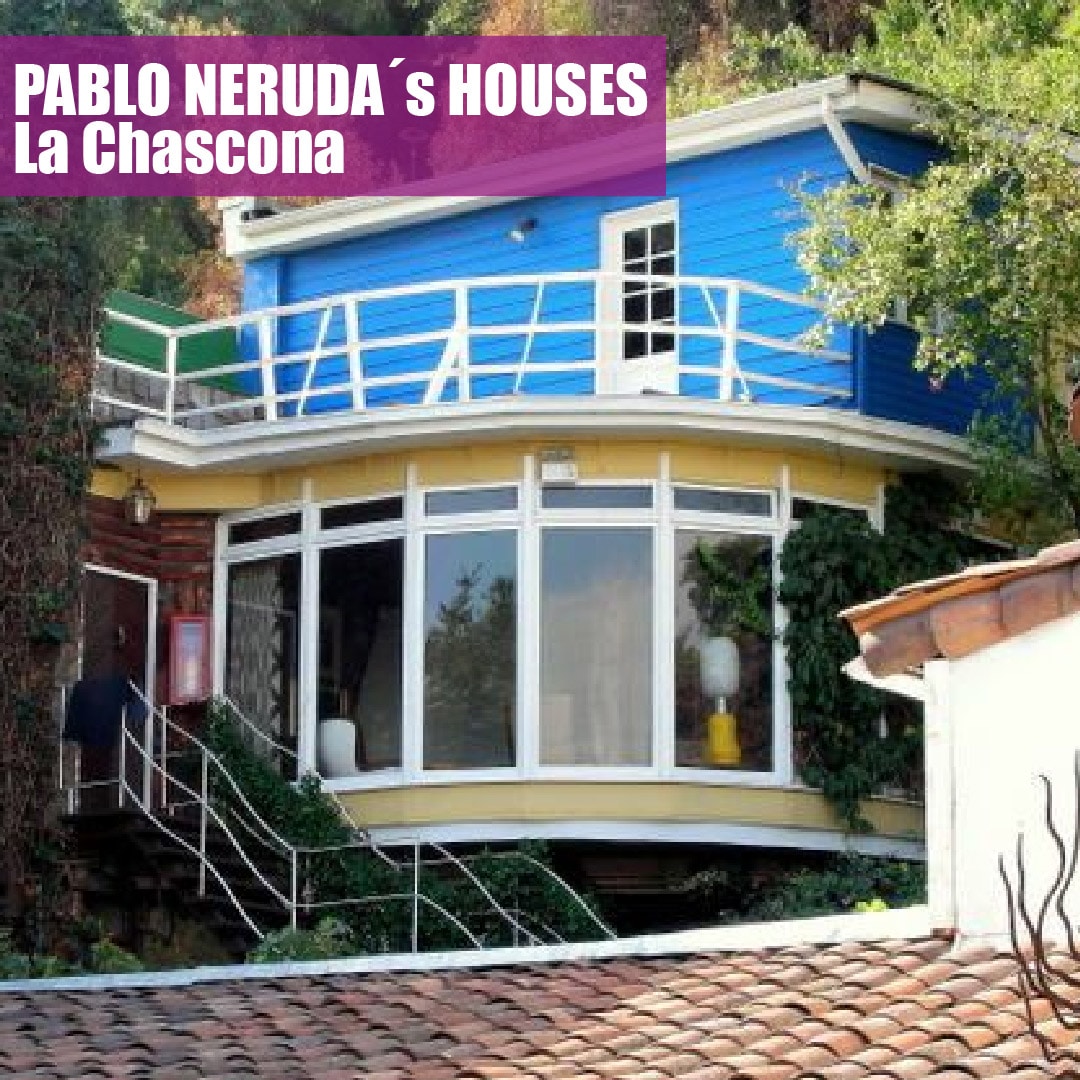
Pablo Neruda´s Houses: La Chascona
One of Neruda’s most famous houses, which was located in Santiago de Chile. His story is very particular, since he participated in absolutely all of its construction. La Chascona was made just as the writer dreamed of it. It was like his escape from reality, and although at first only Matilde lived, later Pablo Neruda moved and began with more renovations. Today this place is known mainly as the headquarters of the foundation, but in addition to that it represents the Pablo Neruda Museum. Pablo Neruda Museum

Pablo Neruda´s Houses: La Sebastiana
A huge house in Valparaíso, where Neruda loved to ring in the new year. There it was possible to find inspiration with the spectacular view it had. Seeing the fireworks was what made the poet so connected to the house. Although at first he considered it very large, he saw more than opportune to stay in the place. La Sebastiana today is a Pablo Neruda house museum, where you can see what the writer’s daily life was like. Pablo Neruda Museum
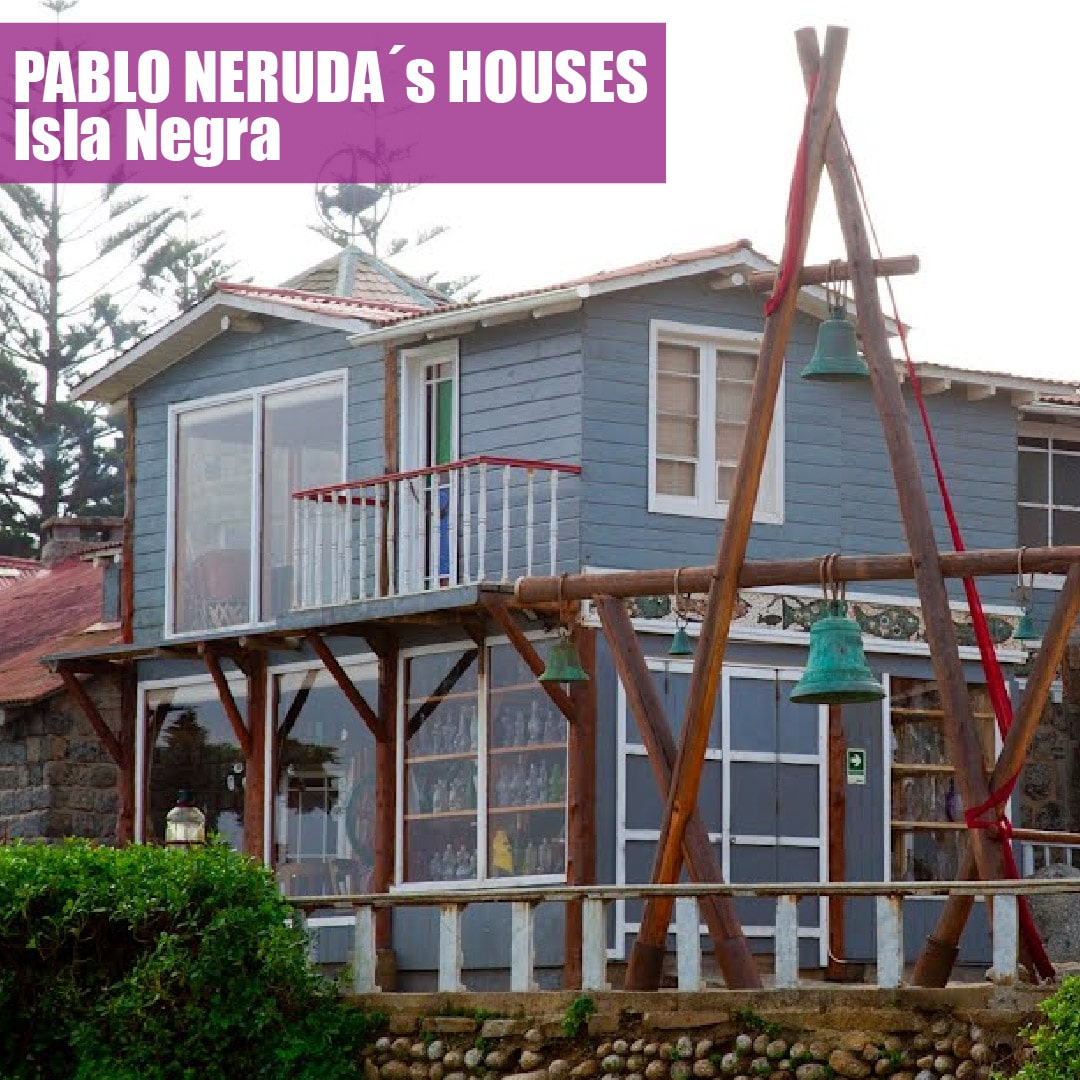
Pablo Neruda´s Houses: Isla Negra
Pablo Neruda’s refuge was undoubtedly this house. He usually spent his national holidays here, without exception. This house has a very conservative atmosphere, and you can even find belongings of the poet that prove it. Before he died, Isla Negra already represented a place of admiration rather than home. This house has a history and a special significance, as it was here that Pablo Neruda found his inspiration to compose such magnificent verses that they would later become poems. Pablo Neruda Museum. The Pablo Neruda museum represents an important point in literature and art. All people are welcome in the place, in fact, school visits are allowed, which must make their reservation in advance.
Book an excursion to enjoy Pomaire and the Pablo Neruda´s House from Santiago de Chile
From Santiago, you can book the excursion to Pomaire and Pablo Neruda´s House.
Visiting Santiago? check our best tours to enjoy Chile
#353 – Santiago, Atacama Desert & Easter Island – 9 nights 
#351 – Santiago, Torres del Paine and Atacama Desert – 9 nights 
#363 – Santiago, Atacama, Torres del Paine & Skorpios III Cruise – 12 nts 
#360 – Chilean Patagonia and Atacama Desert – 12 nts 
Tours in Chile with Argentina, Peru, and other destinations in Chile
It´s a nice list of four tours including the Santiago, Valparaiso and Viña del Mar in the itinerary. But, a great idea is to combine these places, with other destinations in Chile and why not… Argentina and Peru. Check some great options below:
#1052 – From Rio to Santiago via Iguazu, Buenos Aires and Atacama – 18 nts 
#1081 – Colorful Argentina, Chile & Peru – 17 nights 
#1004 – Argentina & Chile in 12 nights – Option IV – 12 nts 
#1090 – The Great tour of South America – 26 nights 
More tours to visit Chile
Want to see more tours to visit Chile? Check our complete list of tours to visit Chile
For more information, just contact us at info@ripioturismo.com
Thank you!


